 |
 |
 |
| |
Insulin Sensitivity: Reyataz/r & Lopinavir/r
|
| |
| |
Reported by Jules Levin
Abstract presented at the 7th International Workshop on Adverse Drug Reactions and Lipodystrophy in HIV 13-16 November 2005, Dublin, Ireland
ABSTRACT 16
Antiviral Therapy 2005; 10:L11
"Evaluation of insulin sensitivity in healthy volunteers treated with low dose ritonavir combined with atazanavir (ATV/RTV) or lopinavir (LPV/RTV):
a prospective, randomized study using hyperinsulinaemic, euglycaemic clamp and oral glucose tolerance testing"
MA Noor1, OP Flint1, RA Parker1, J Maa1, J Witek1 and SL Hodder 2
1Pharmaceutical Research Institute, Bristol-Myers Squibb
Company, Princeton, NJ, USA; 2Department of Medicine, University
of Medicine and Dentistry New Jersey, Newark, NJ, USA
note from Jules Levin: the daily ritonavir doses were different in this study, 200 for atazanavir vs 100 mg per day for lopinavir.
Primary Objective-
Change from baseline insulin sensitivity expressed as glucose disposal rate per unit of insulin during last hour of euglycemic clamp after treatment with ATV/r and LPV/r in healthy HIV sero-negative subjects.
Secondary Objectives:
To assess the change from baseline between the effects of ATV/r & LPV/r on:
--oral glucose tolerance
--lipids & lipoproteins
To describe the steady-state PK of ATV, LPV, and RTV.
Study Schematic
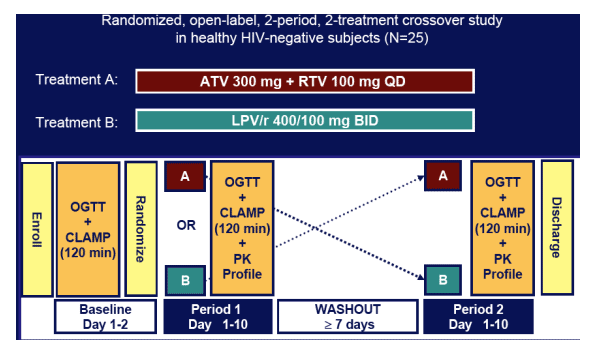
BACKGROUND
Treatment with some HIV Protease Inhibitors, including indinavir, ritonavir (RTV) and lopinavir/ritonavir (LPV/r)3has been shown to induce insulin resistance acutely by euglycemic clamp in healthy HIV-negative volunteers.
Previously, in a randomized placebo-controlled cross-over study, we demonstrated that atazanavir (ATV) did not affect insulin sensitivity by euglycemic clamp acutely while LPV/r reduced insulin sensitivityby 24% vs. placebo.
Many patients on ATV-containing HAART also receive low dose (100 mg) of RTV for enhanced pharmacokinetics (ATV/r).
In another euglycemic clamp study, however, a single therapeutic dose of RTV (800 mg) reduced insulin sensitivity by 21%.
Combining up to 2 _M (~1400 ng/ml) of RTV with ATV did not further impair insulin-stimulated glucose uptake in vitro.
Background: Effect of Single-Dose ATV/RTV and IDV/RTV on Dose ATV/RTV and IDV/RTV on Insulin Sensitivity by Euglycemic Clamp in Healthy Subjects
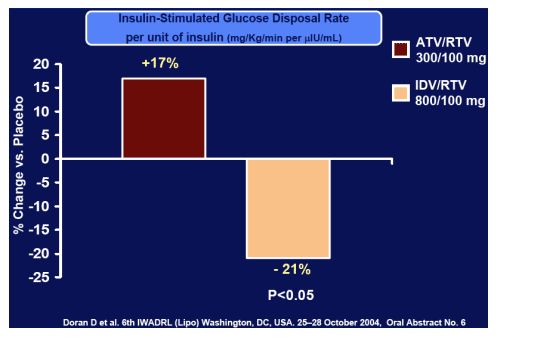
Methods: Randomized, cross-over study comparing the effects of ATV/RTV (300/100 mg once daily) and LPV/RTV (400/100mg twice daily) on insulin sensitivity in 24 healthy HIV-negative subjects. Change in insulin sensitivity was assessed by euglycaemic hyperinsulinaemic clamp (SIclamp) and by oral glucose tolerance test (OGTT) expressed as area under the curve (AUC) during 3 h. Subjects were studied at baseline (BL) and after 10 days of treatment, with a wash-out period between the treatments. Differences from BL and between treatments were assessed by ANOVA.
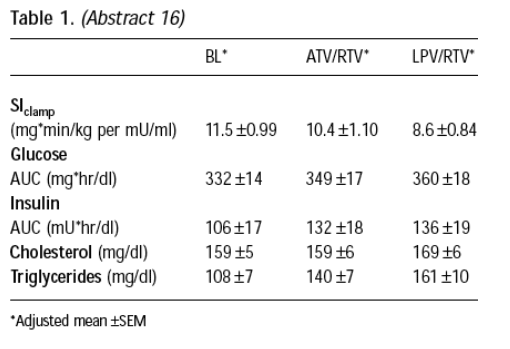
Results: There was no significant change from BL in SIclamp on ATV/RTV (-10%, P=0.132). SIclamp decreased significantly on LPV/RTV relative to BL (-25%, P<0.001) and relative to ATV/RTV (-18%, P=0.023). The glucose
AUC increased significantly from BL on LPV/RTV (P=0.032) but not on ATV/RTV (P=0.184 vs BL). The insulin AUC increased significantly from BL for both regimens (P=0.023 vs ATV/RTV and P=0.01 vs LPV/RTV). Total cholesterol increased significantly on LPV/RTV (P=0.015 vs BL; P=0.003 vs ATV/RTV). Triglycerides increased significantly from BL on both regimens (P=0.001 vs ATV/RTV, P<0.001 vs LPV/RTV) but the increase was higher on LPV/RTV (P=0.012 vs ATV/RTV).
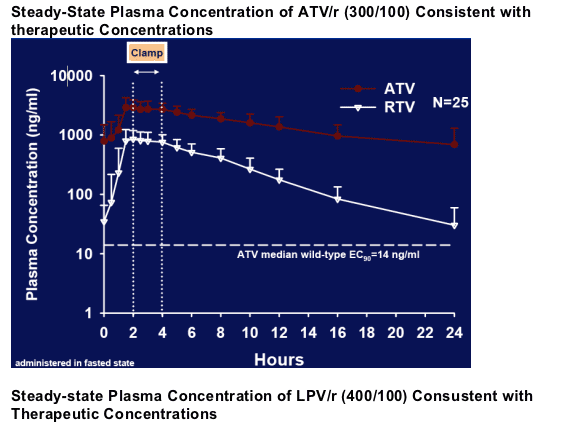
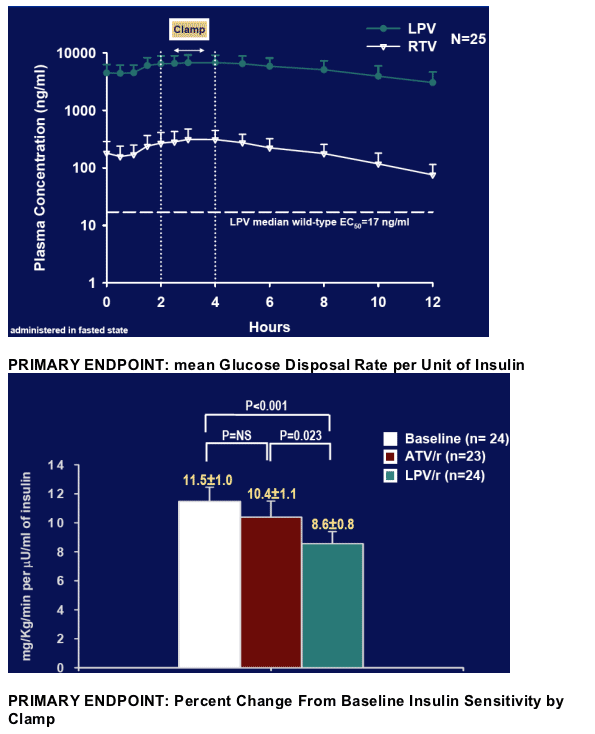
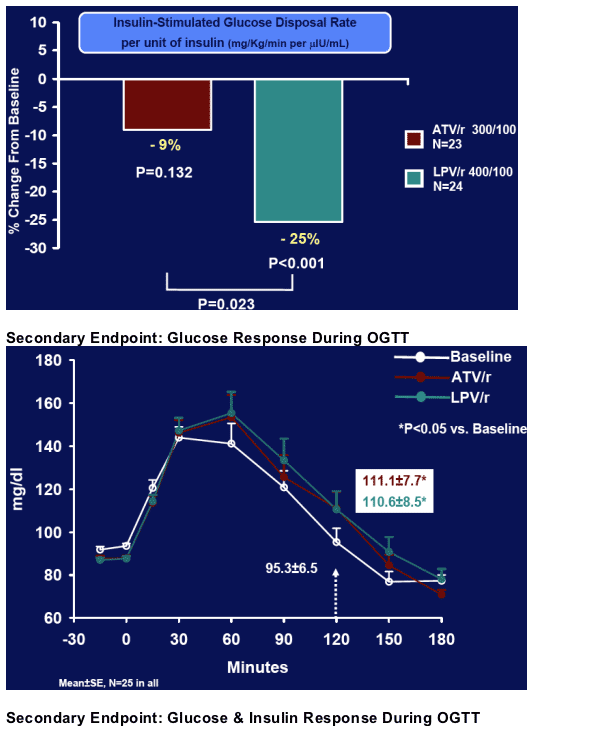
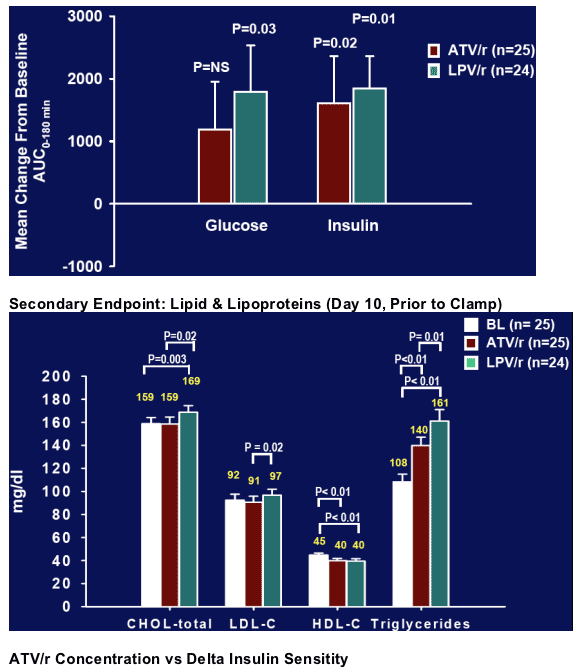
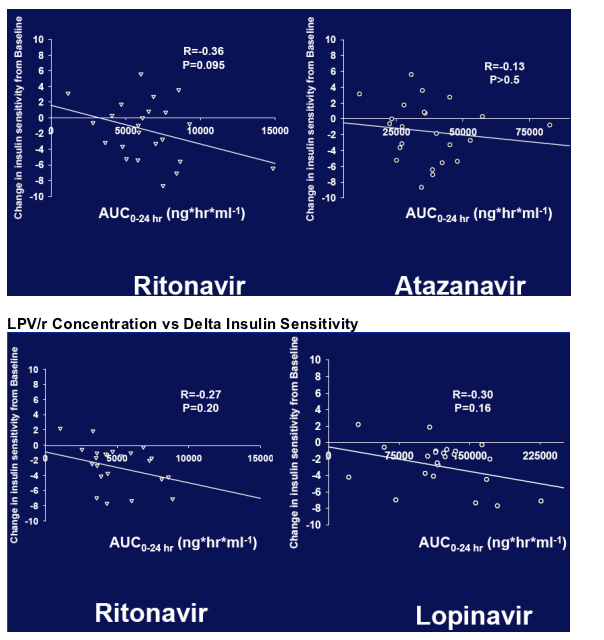
Conclusions: Treatment with RTV in combination with ATV for 10 days did not significantly affect insulin sensitivity by clamp. A small increase from BL in insulin AUC during OGTT was perhaps due to an increase in triglycerides. In contrast administration of LPV/RTV induced insulin resistance by clamp and OGTT with greater increases in triglycerides. Further data should assess clinical significance for diabetes outcome.
Primary Endpoint:
ATV/r did not induce significant insulin resistance by clamp.
LPV/r induced significant insulin resistance:
--insulin sensitivity -25% relative to baseline (p<0.001) and -18% relative to ATV/r (p=0.02).
--similar to in vitro data and of same magnitude made in earlier observations.
Secondary Endpoints:
OGTT
--ATV/r increased AUC for insulin
--LPV/r increased AUC for insulin & glucose
--both increase 2-hr glucose time point but average within normal limits
Lipids
--ATV/r had no significant effect on TC or LDL-C
--LPV/r increased both TC & LDL-C
--both increased TGs with LPV/r>ATV/r (48% vs 30%, p=0.01)
Confirmation of these findings in HIV+ population & implications for diabetes outcomes are needed.
|
|
| |
| |
|
 |
 |
|
|